AUDI Q5 2015 Owners Manual
Manufacturer: AUDI, Model Year: 2015, Model line: Q5, Model: AUDI Q5 2015Pages: 302, PDF Size: 75.01 MB
Page 221 of 302
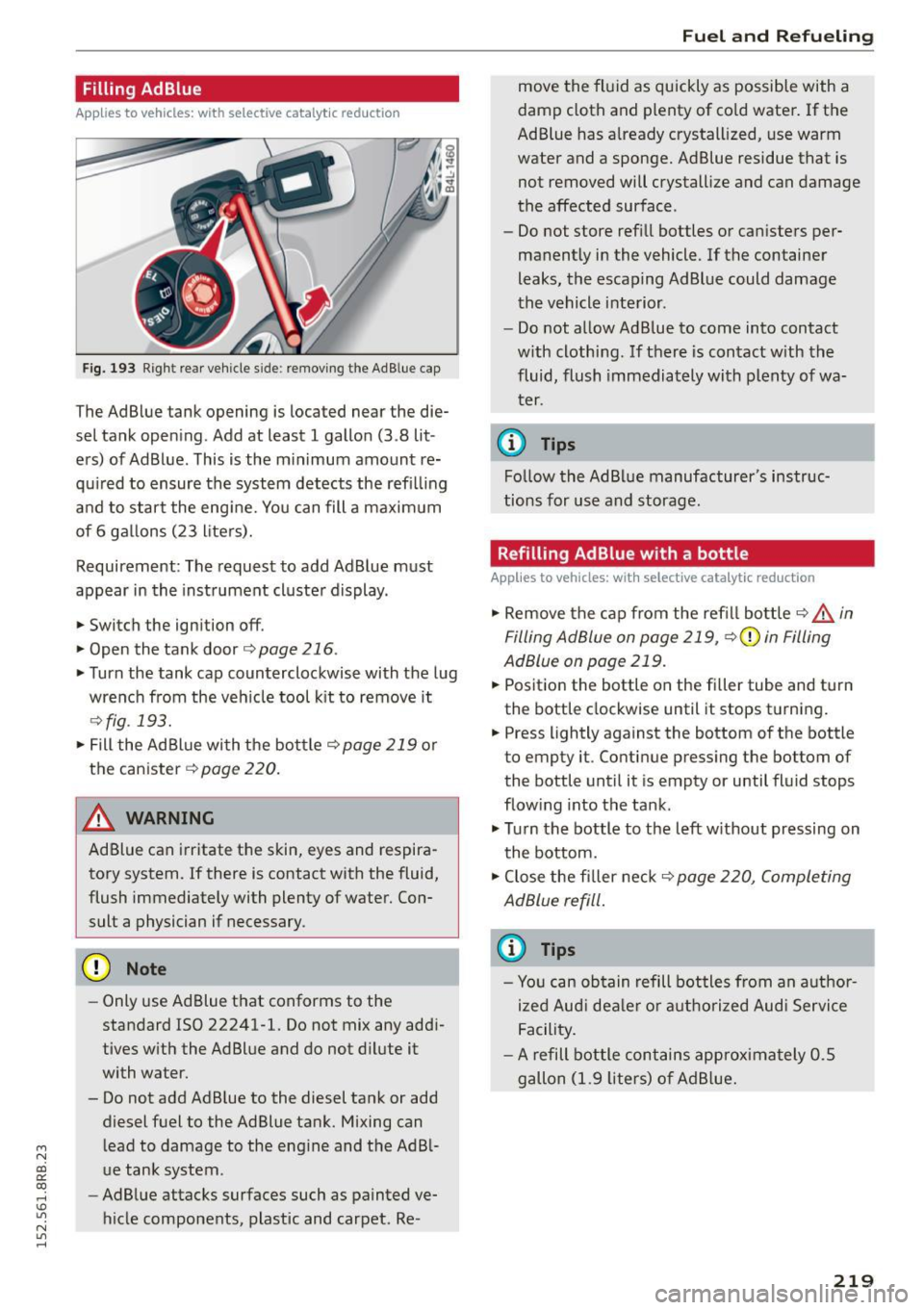
M N
co ~ co
rl I.O
"' N
"' rl
Filling AdBlue
Applies to vehicles: with selective catalytic reductio n
Fig. 193 Right rear vehicle s ide: remov ing the Ad Blue cap
The Ad Blue tank opening is located near the die
sel tank opening . Add at least 1 gallon (3 .8 lit
ers) of AdBlue. This is the m inimum amount re
qu ired to ensure the system detects the ref illing
and to start the eng ine. You can fill a maximum
of 6 ga llons (23 l iters).
Requirement: The request to add Ad Blue must
appear in the instrument cluster display.
.,. Switch the ign ition off.
.,. Open the tank door¢
page 216 .
.,. Turn the tank cap counterclockwise with the lug
wrench from the veh icle tool kit to remove it
9fig. 193.
.,. Fill the Ad Blue with the bottle¢ page 219 or
the canister
¢ page 220.
A WARNING
Ad Blue can irritate the skin, eyes and respira
tory system. If there is contact with the fluid,
flush immediately with plenty of water. Con sult a physician if necessary.
CI) Note
- Only use Ad Blue that conforms to the
standard ISO 22241-1. Do not mix any addi
tives with the AdBlue and do not dilute it
with water.
- Do not add Ad Blue to the diesel tank or add
diesel fuel to the Ad Blue tank. Mixing can
lead to damage to the eng ine and the Ad B l
ue tank system.
- AdBlue attacks surfaces such as painted ve
hicle components, plastic and carpet. Re-
Fuel and Refueling
move the fluid as quickly as possible with a
damp cloth and plenty of cold water. If the
Ad Blue has already crystall ized, use warm
water and a sponge. Ad Blue residue that is
not removed will crystallize and can damage
the affected surface.
- Do not store refill bottles or can isters per
manently in the vehicle. If the container
leaks, the escaping AdBlue could damage
the vehicle interior.
- Do not allow Ad Blue to come into contact
with clothing. If there is contact w ith the
fluid, flush immediately with plenty of wa
ter .
@ Tips
Follow the AdBlue manufacturer's instruc
tions for use and storage.
Refilling Ad Blue w ith a bottle
Applies to vehicles: with selective catalytic reduction
.,. Remove the cap from the ref ill bott le 9 _& in
Filling AdBlue on page
219, ¢(Din Filling
AdBlue on page
219 .
.,. Posit ion the bottle on the filler tube and t urn
the bottle clockwise until it stops turning.
.,. Press lightly against the bottom of the bottle
to empty it . Continue pressing the bottom of
the bottle until it is empty or until fluid stops
flow ing into the tank.
.,. Turn the bottle to the left without pressing on
the bottom.
.,. Close the filler neck
9 page 220, Completing
AdBlue refill.
{i) Tips
- You can ob tain refill bottles from an author
ized Aud i deale r or authorized Audi Service
Facility.
- A refill bottle contains approximately 0 .5
gallon (1.9 liters) of AdBlue.
219
Page 222 of 302
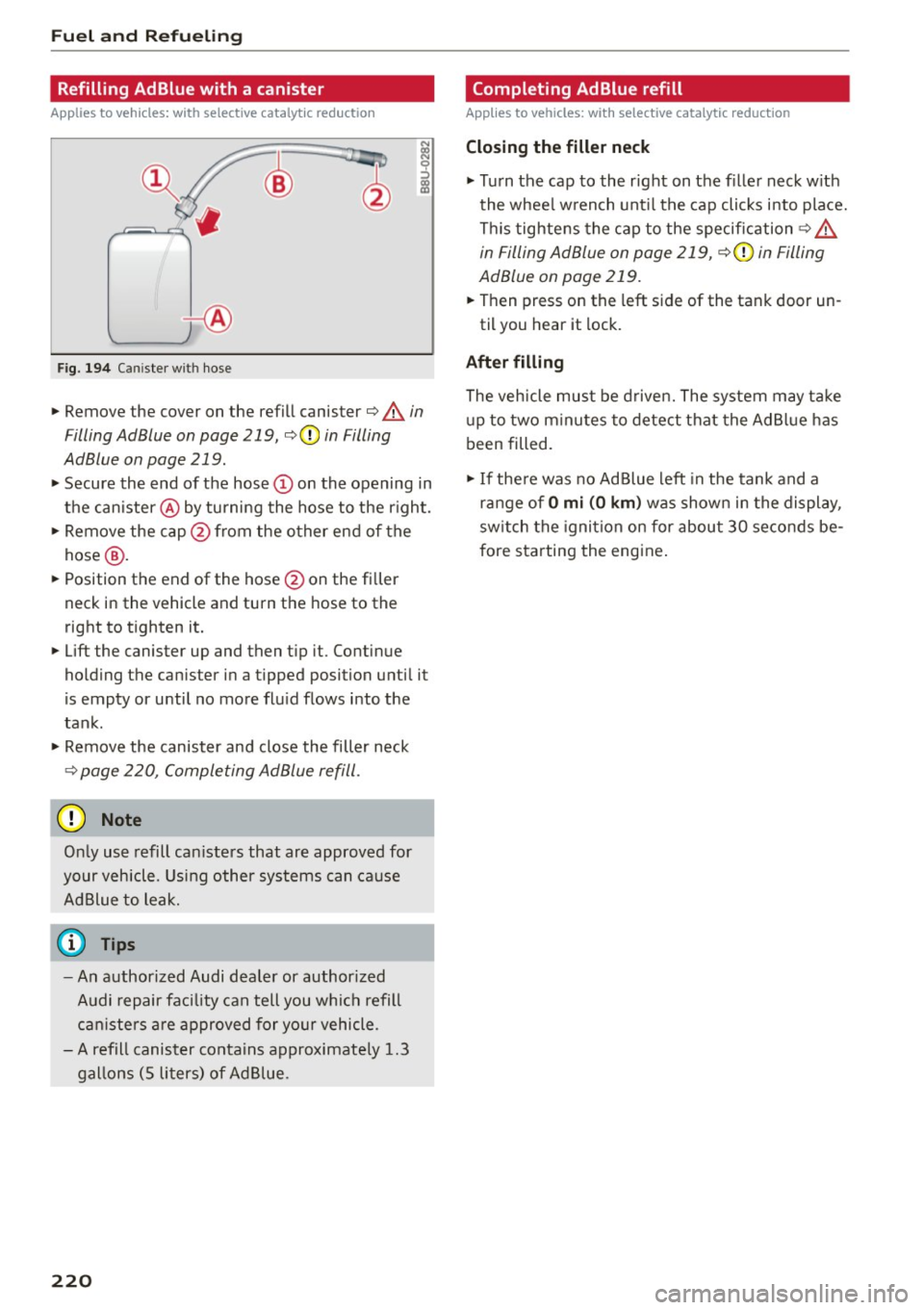
Fuel and Refu elin g
Refilling AdBlue with a canister
App lies to veh icles: w ith selective cata lyt ic red uctio n
@
+®
Fig. 194 Canister with hose
"' Remove the cover on the refill canister c:::> A in
Filling Ad Blue on page 219,
c:::> 0 in Filling
AdBlue on page 219 .
"' Secure the end of the hose(!) on the opening in
the canister @ by turning the hose to the r ight.
"' Remove the cap @from the other end of the
hose @.
"' Position the end of the hose @on the fi ller
neck in the vehicle and turn the hose to the
right to tighten it.
"'Lift the canister up and then tip it. Continue
holding the canister in a tipped position until it
is empty or until no more flu id flows into the
tank .
"' Remove the canister and close the filler neck
c:::> page 220, Completing AdBlue refill .
0 Note
Only use refill canisters that are approved for
your vehicle. Us ing other systems can cause
Ad Blue to leak.
@ Tips
- An authorized Audi dealer or author ized
Audi repair facility can tell you w hich refill
can iste rs a re approved for your vehicle.
- A refill canister contains approximate ly 1. 3
gallons (5 liters) of Ad Blue.
220
Completing AdBlue refill
App lies to vehicles: wit h selective cata lyt ic reduction
C losin g the filler neck
"'Turn the cap to the right on the filler neck w ith
the wheel w rench until the cap clicks i nto place.
This tightens the cap to the specification
c:::> A
in Filling AdBlue on page 219, c:::> 0 in Filling
AdBlue on page 219.
"'Then press on the left side of the tank door un-
til you hear it lock.
Aft er filling
The vehicle must be driven. The system may take
up to two m inutes to detect that the Ad Blue has
been filled.
"' If there was no AdBlue left in the tank and a
range of
O mi (0 km ) was shown in the display,
sw itch the ignition on for about 30 seconds be
fore starting the engine.
Page 223 of 302
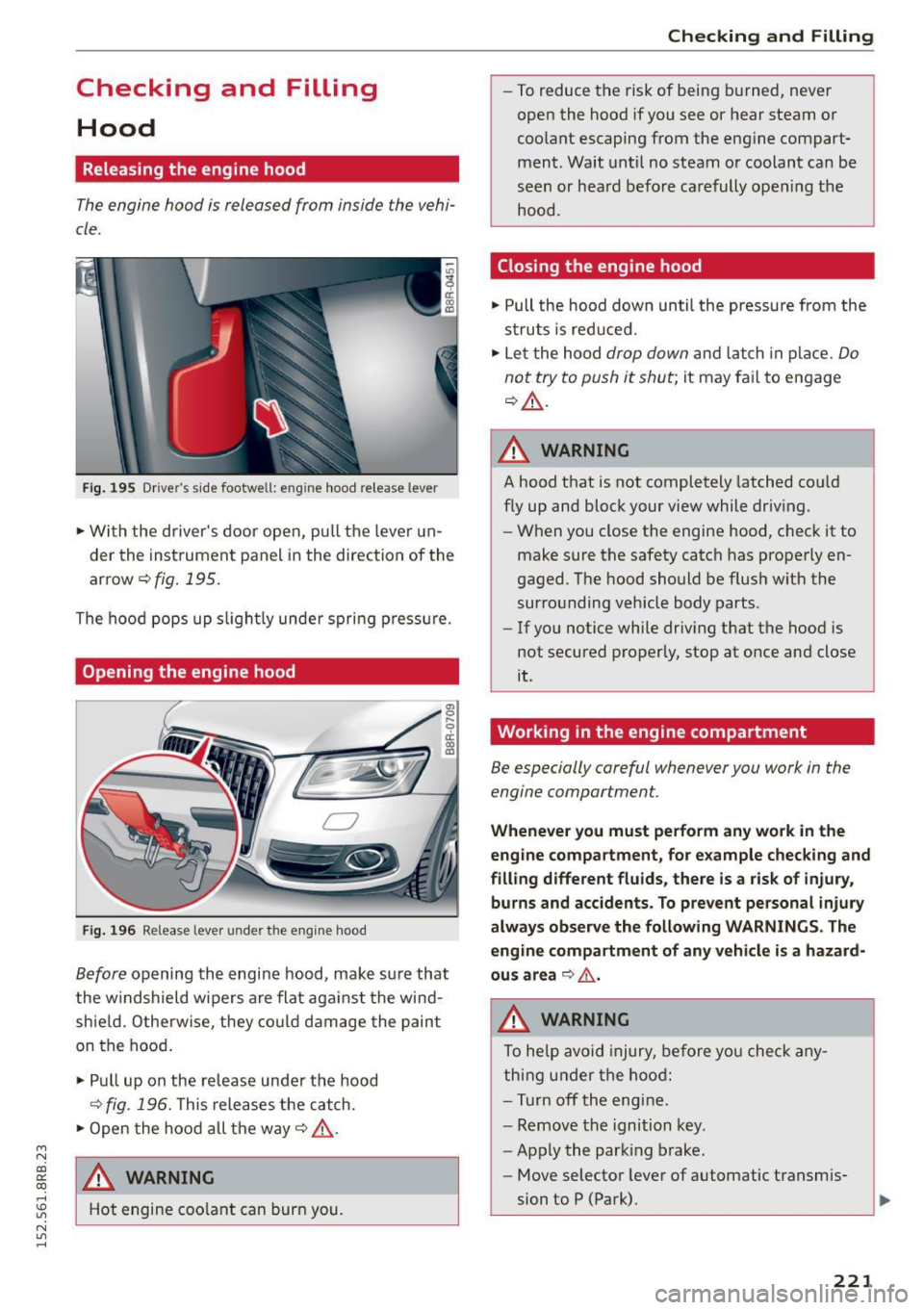
M N
Checking and Filling Hood
Releasing the engine hood
The engine hood is released from inside the vehi
cle .
Fig . 195 Drive r's side footwe ll: e ng ine hood re lease lever
"' Wi th the driver's door open, pu ll the leve r un
der the instrument panel in the direction of the
arrow
c::> fig . 195.
The hood pops up s light ly under spri ng press ure.
Opening the engine hood
Fig. 196 Relea se leve r un der the eng ine hood
Before opening the engine hood, make su re that
the w indshield wipers are flat aga inst the wind
shield. Otherwise, they could damage the paint
on the hood .
"' Pull up on the release under the hood
c:> fig . 196. This releases the catch.
"' Open the hood all the way
c::> A.
~ _&. WARNING
rl
:5: Hot engine coo lant can burn you.
N l/1 rl
Ch eck in g and Fillin g
-To reduce the risk of being burned, never
open the hood if you see or hear steam or
coolant escaping from the eng ine compart
ment. Wait until no steam or coolant can be
seen or heard before carefully opening the hood.
Closing the engine hood
"' Pull the hood down until the pressu re from the
struts is reduced.
"' Le t the hood
drop down and latch in p lace. Do
not try to push it shut;
it may fa il to engage
c::> A .
A WARNING
-
A hood that is not completely latched cou ld
fly up and block your view while driv ing.
-
- When you close the engine hood, check it to
make sure the safety catch has properly en
gaged . The hood should be flush with the
surrounding vehicle body parts .
- If you notice while driv ing that the hood is
not secured properly, stop at once and close
it .
Working in the engine compartment
Be especially careful whenever you work in the
engine compartment.
Wheneve r you must pe rfo rm an y wo rk in the
eng ine comp artment , for e xample chec king and
fi lling differen t fluids , ther e is a ri sk of i nju ry,
bu rn s and acci den ts. To p re ve nt pe rsonal injur y
al way s ob serve the follo wing WARN INGS . The
e ngi ne compartm ent of an y ve hicle is a haza rd
ou s area
~ ,&..
A WARNING
To help avoid injury, before you check any
thing under the hood:
- Turn off the eng ine.
- Remove the ignition key.
- Apply the parking brake.
-
- Move selector lever of automatic transmis-
sion to P (Park).
221
Page 224 of 302
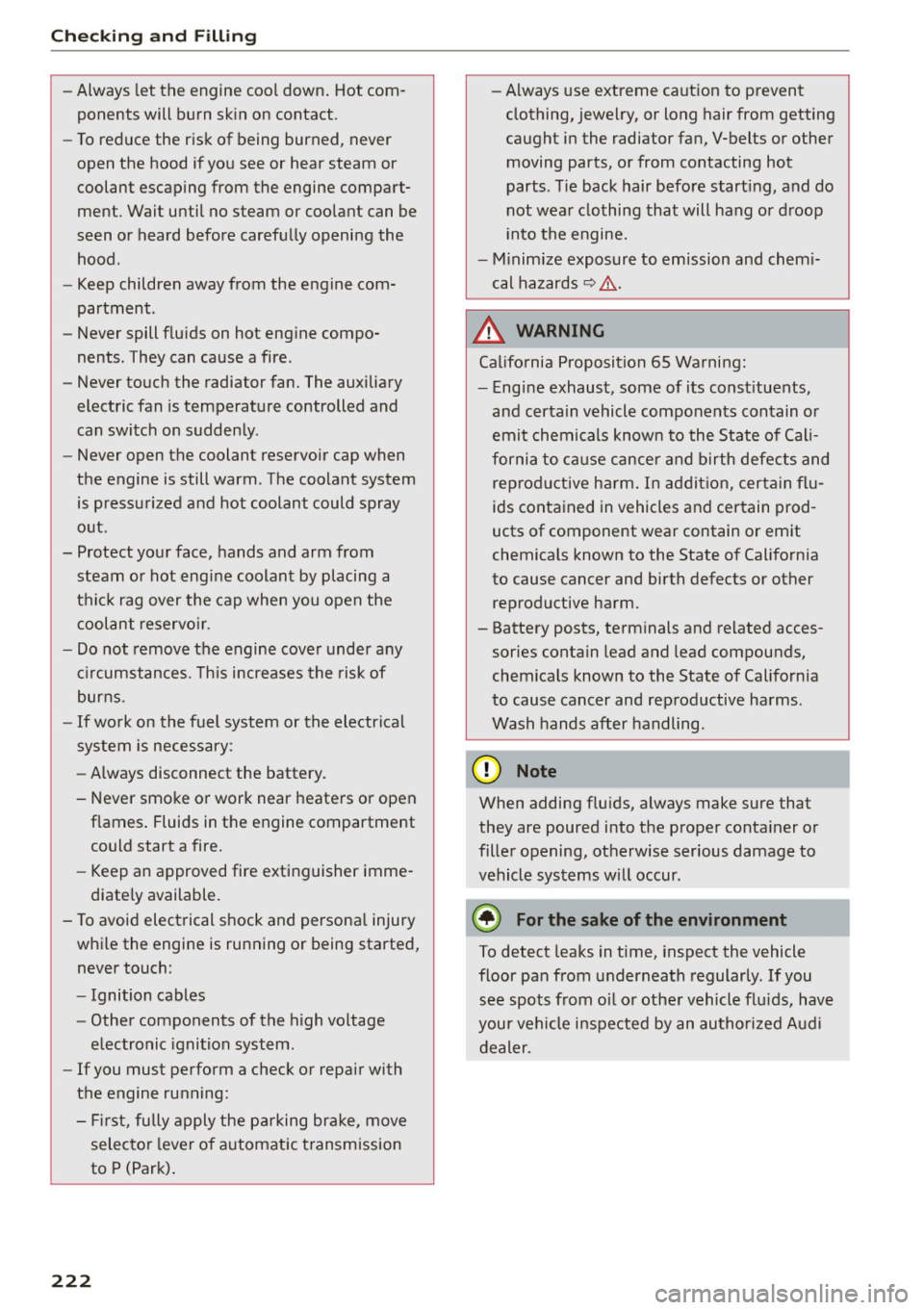
Checking and Filling
-Always let the engine cool down. Hot com
ponents will burn skin on contact .
- To reduce the risk of being burned, never
open the hood if you see or hear steam or
coolant escaping from the engine compart
ment . Wait until no steam or coolant can be
seen or heard before carefully opening the
hood.
- Keep children away from the engine com
partment .
- Never spill fluids on hot engine compo
nents . They can cause a fire .
- Never touch the radiator fan. The auxiliary
electric fan is temperature controlled and
can switch on suddenly.
- Never open the coolant reservoir cap when
the engine is still warm. The coolant system
is pressurized and hot coolant could spray
out .
- Protect your face, hands and arm from steam or hot engine coolant by placing a
thick rag over the cap when you open the coolant reservoir .
- Do not remove the engine cover under any
circumstances. This increases the risk of
burns.
- If work on the fuel system or the electrical
system is necessary :
- Always disconnect the battery.
- Never smoke or work near heaters or open
flames . Fluids in the engine compartment
could start a fire.
- Keep an approved fire extinguisher imme
diately available.
- To avoid electrical shock and personal injury
while the engine is running or being started, never touch:
- Ignition cables
- Other components of the high voltage
electronic ignition system.
- If you must perform a check or repair with
the engine running:
- First, fully apply the parking brake , move
selector lever of automatic transmission
to P (Park).
222
- Always use extreme caution to prevent
clothing, jewelry, or long hair from getting
caught in the radiator fan, V-belts or other
moving parts, or from contacting hot
parts . Tie back hair before starting, and do
not wear clothing that will hang or droop
into the engine.
- Minimize exposure to emission and chemi
cal hazards
~ ,&. .
&, WARNING
California Proposition 65 Warning:
- Engine exhaust , some of its constituents,
and certain vehicle components contain or
emit chemicals known to the State of Cali
fornia to cause cancer and birth defects and
reproductive harm. In addition, certain flu
ids contained in vehicles and certain prod
ucts of component wear contain or emit
chemicals known to the State of California
to cause cancer and birth defects or other
reproductive harm.
- Battery posts, terminals and related acces sories contain lead and lead compounds,
chemicals known to the State of California
to cause cancer and reproductive harms .
Wash hands after handling .
('.!) Note
When adding fluids, always make sure that
they are poured into the proper container or
filler opening, otherwise serious damage to
vehicle systems will occur.
@ For the sake of the environment
To detect leaks in time, inspect the vehicle
floor pan from underneath regularly. If you
see spots from oil or other vehicle fluids, have
your vehicle inspected by an authorized Audi dealer.
Page 225 of 302
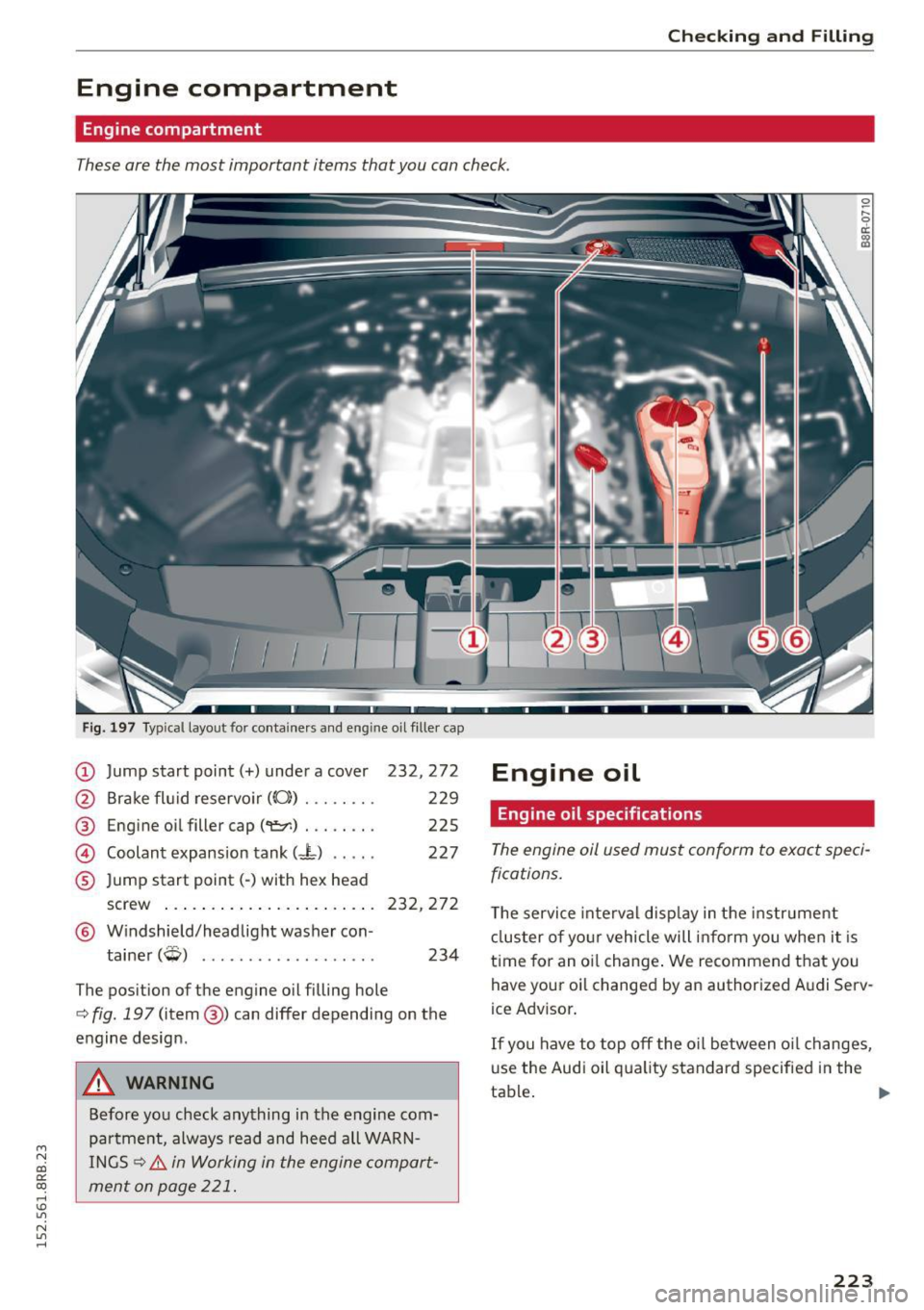
M N
co ~ co
rl I.O
"' N
"' rl
Checking and Filling
Engine compartment
Engine compartment
These are the mos t important item s that you can check .
Fig. 197 Typical layou t fo r container s and e ngine oil filler ca p
(D Jump start point(+) under a cover 23 2, 272
@ Brake fluid reservoir (0) . . . . . . . . 229
@ Engine oil filler cap(~) . . . . . . . . 225
@ Coolant expansion tank (- L) . . . . . 227
® Jump start point(-) w ith hex head
s crew . . . . . . . . . . . . . . . . . . . . . . . 232, 272
@ Windshield/headlight washer con -
tainer
(Q) . . . . . . . . . . . . . . . . . . . 234
T he po sit ion of the engine oil filling hole
c:> fig. 197 (item @) can differ depending on the
engine design .
A WARNING
Before you check anything in the engine com
partment, always read and heed all WARN
INGS
c:> &. in Working in the engine compart
ment on page 221.
Engine oil
Engine oil specifications
The engine oil used must conform to exact sp eci
f ications.
T he service interval disp lay in the instrument
cluster of your vehicle will inform you when it is
time for an oi l chang e. We recommend that you
hav e your oil chang ed by an authori zed A udi Serv
ic e Advi sor .
If you have to top off the oil between oil changes,
use the Audi oil qua lity standa rd specified in the
tab~ .
~
223
Page 226 of 302
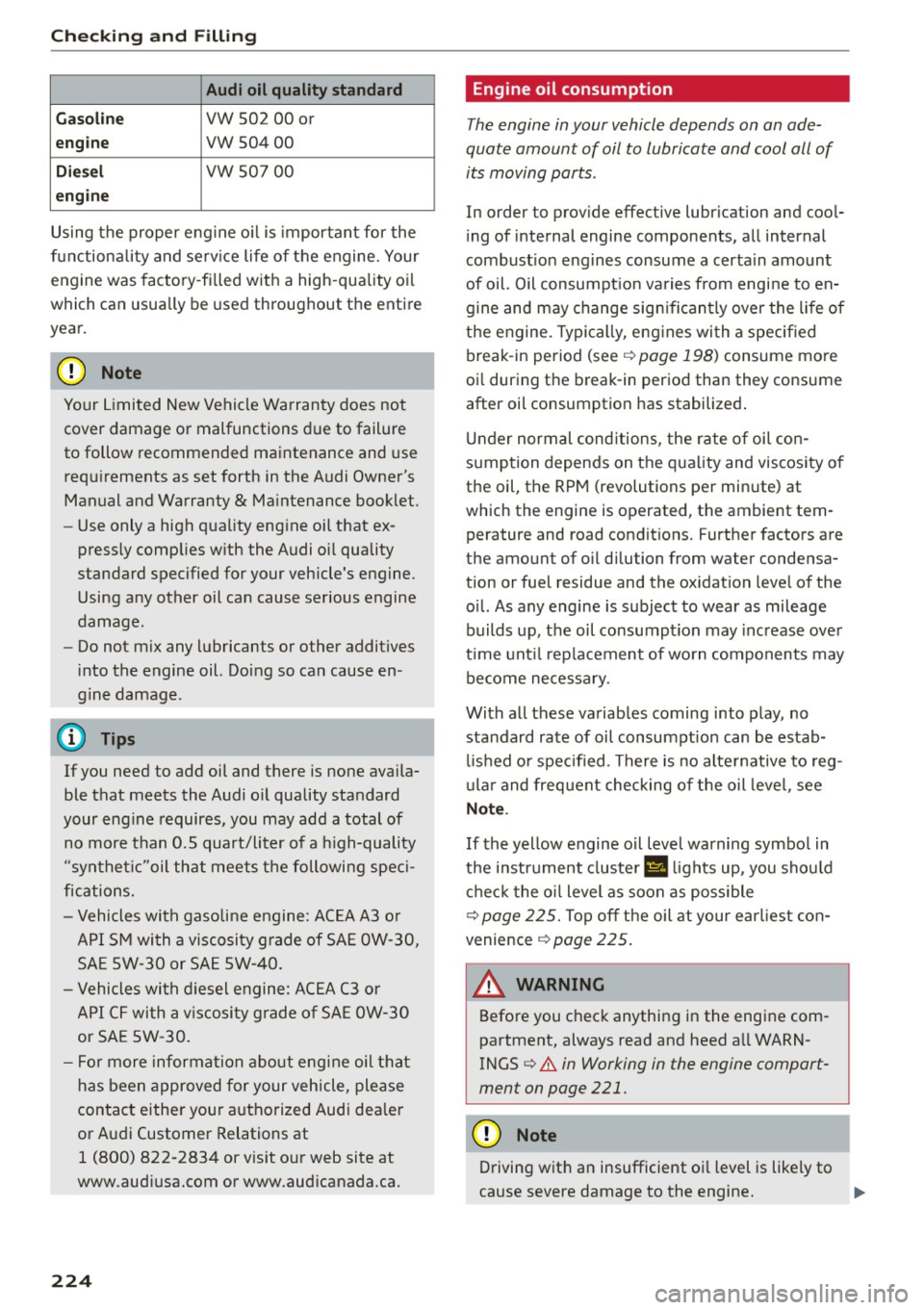
Checking and F ill in g
Audi oil quality standard
Gas oline VW 502 00 or
engi ne
vw 504 00
Die sel
vw 50 7 00
e n g in e
Using the proper engine o il is important for the
functionality and serv ice life of the engine. Your
engine was facto ry-filled with a high-qua lity oil
which can usually be used throughout the entire
year.
(D Note
Your Limited New Vehicle Warranty does not
cover damage or malfunctions due to failure
to follow recommended maintenance and use
requirements as set forth in the Audi Owner's Manual and Warranty
& Ma intenance booklet.
- Use only a high qua lity eng ine oil that ex-
pressly complies w ith the Audi o il quality
standard specified for your vehicle's engine.
Using any other oil can cause serious engine
damage.
- Do not mix any lubricants or other additives
into the engine oil. Doing so can cause en
gine damage.
(D Tips
If you need to add oil and there is none availa
ble that meets the Audi o il quality standard
your eng ine requires, you may add a total of
no more than 0.5 quart/liter of a h igh-quality
"synthe tic"oil that meets the followi ng speci
fications.
- Vehicles with gasoli ne engine: AC EA A3 o r
API SM wi th a viscosity g rade of SAE OW-30,
SA E SW-30 or SAE SW-40 .
- Vehicles wi th d iesel engine: AC EA C3 o r
API CF wi th a v iscosi ty grade of SA E OW-30
or SAE SW-30.
- Fo r more information abo ut eng ine oil t hat
has been approved for your vehicle, please
contact eithe r your a uthorized Audi dea le r
or A udi Customer Relations at
1 (800) 822-2834 or visit our web site at
www.aud iusa.com or www .aud icanada.ca.
224
· Eng ine oil consumption
The engine in your vehicle depends on an ade
quate amount of oil to lubricate and cool all of
its moving parts.
In order to prov ide effective lubrication and coo l
i ng of internal engine components, all internal
combust ion engines consume a certa in amount
of oil. Oil consumpt ion va ries from engine to en
gine and may change sig nificantly over the life of
the engine. Typically, eng ines wi th a specified
break -in period (see¢
page 198) consume mo re
o il during t he b reak-in period than they co nsume
after oil consumption has stabilized .
Un der normal cond itions, the rate o f oi l con
sumption depends on the q uality and viscos ity o f
the oil, the RPM (revolutions per min ute) at
which the engine is operated, the ambient tem perature and road condit ions. Further factors are
the amount of o il dilution from water condensa
tion or fuel residue and the ox idat ion leve l of the
o il. As any engine is subject to wear as mileage
builds up, the oil consumption may inc rease over
time unt il rep lacement of worn compone nts may
become necessary.
With a ll these variab les coming into p lay, no
standard rate of oil consumpt ion can be estab
li shed or spec ified. There is no alte rnative to reg
u lar and frequent checking of the oil leve l, see
Note .
If the yellow engine oil leve l warning symbo l in
the i nstrument cluster
II lights up, you should
c h ec k t he o il level as soon as poss ible
cf> page 2 25. Top off the oil at your ear liest con
venience
r:!> page 225.
A WARNING
Before you check anything in the engine com
partment, always read and heed a ll WARN
INGS¢ .&.
in Working in the engine compart
ment on page 221.
(D Note
Driving wit h an insufficient oi l level is likely to
cause severe damage to the engine.
liJJ,
Page 227 of 302
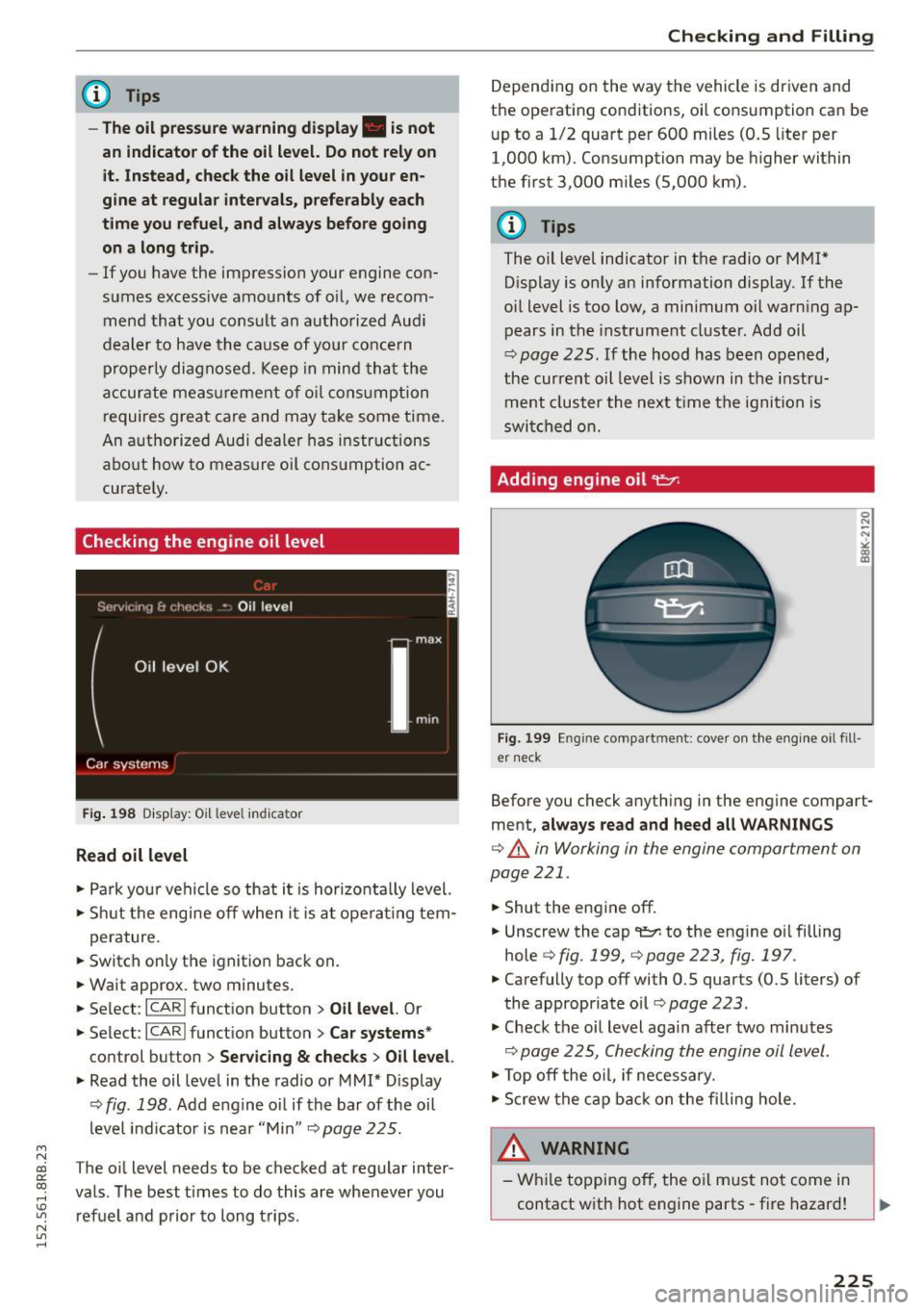
M N
co ~ co
rl I.O
"' N
"' rl
@ Tips
-The oil pressure warning display. is not
an indicator of the oil level. Do not rely on
it. Instead, check the oil level in your en
gine at regular intervals, preferably each
time you refuel , and always before going
on a long trip .
-If you have the impression your engine con
sumes excess ive amounts of o il, we recom
m end th at you cons ult an a uthorized Aud i
deal er to have th e cau se of yo ur co nc ern
p ro perly di ag no se d . Keep i n mi nd th at the
a ccurate meas ureme nt o f oil c onsu mpti on
r equires great care and m ay ta ke some time.
An a uthorized Audi dea ler has i nstr uctions
abo ut how to meas ure o il cons umption ac
curate ly.
Checking the engine oil level
F ig. 19 8 Disp lay: O il level indicator
Read oil level
.. Pa rk your vehicle so that i t is hor izont ally level.
.. Shu t the engine off when i t is at oper ating te m-
perature.
.. Switc h on ly the ignition back on.
.. Wa it approx. two minutes .
.. Se lect:
I CARI funct ion button > Oil level. Or
.. Select:
ICARI funct ion button> Car systems *
control button > Servicing & checks > Oil level.
.. Read the oil leve l in the radio or MMI* Display
¢ fig . 198. Add e ng in e oil if the bar of the oil
l evel i ndicator is nea r "M in"
9page 225.
The oil level needs to be c hec ked at regular inter
va ls. The best t im es to do this are whenever you
ref uel and prior to long t rips.
Checking and Filling
D epend ing on the way t he vehicle is dr iven and
the ope rat ing cond itions, oil consumption ca n be
u p to a 1/2 quart pe r 600 miles (0 .5 liter per
1,000 km). Consumption may be higher within
the fi rst 3,000 mi les (5,000 km).
(D Tips
The oil leve l indicator in t he ra dio or MMI*
D isp lay is only an information display. If t he
o il level is too low , a minimum oi l warn ing ap
p ears in the instrume nt cl uster. Add oil
¢ page 225. If the hood has been o pen ed,
t h e cur ren t oil leve l is shown in t he instru
m ent cl uster the n ext tim e the ig niti on i s
sw itch ed on.
Adding engine oil
Fig . 199
Engine compa rtment: cove r on th e e ng in e oi l fill
er neck
Befo re you check a nyth ing in the engine compart
ment ,
always read and heed all WARNINGS
¢ & in Working in the engine compartment on
page 221 .
.. Shut the eng ine off .
.. Unscrew the cap
'l!:7-to the eng ine o il filling
hole
¢ fig. 199, 9page223, fig.197 .
.. Carefully top off with 0.5 quarts (0.5 liters) of
the appropriate oil ¢
page 223 .
.. Check t he oil level aga in after two m inutes
<:> page 225, Checking th e e ngin e oil l eve l.
.. Top off the o il, if necess ary .
.. Scr ew the cap back on the filling hole.
& WARNING
-
- W hile to p pin g off , the o il m ust not come in
contact w ith hot e ngine parts - fire hazar d!
225
Page 228 of 302
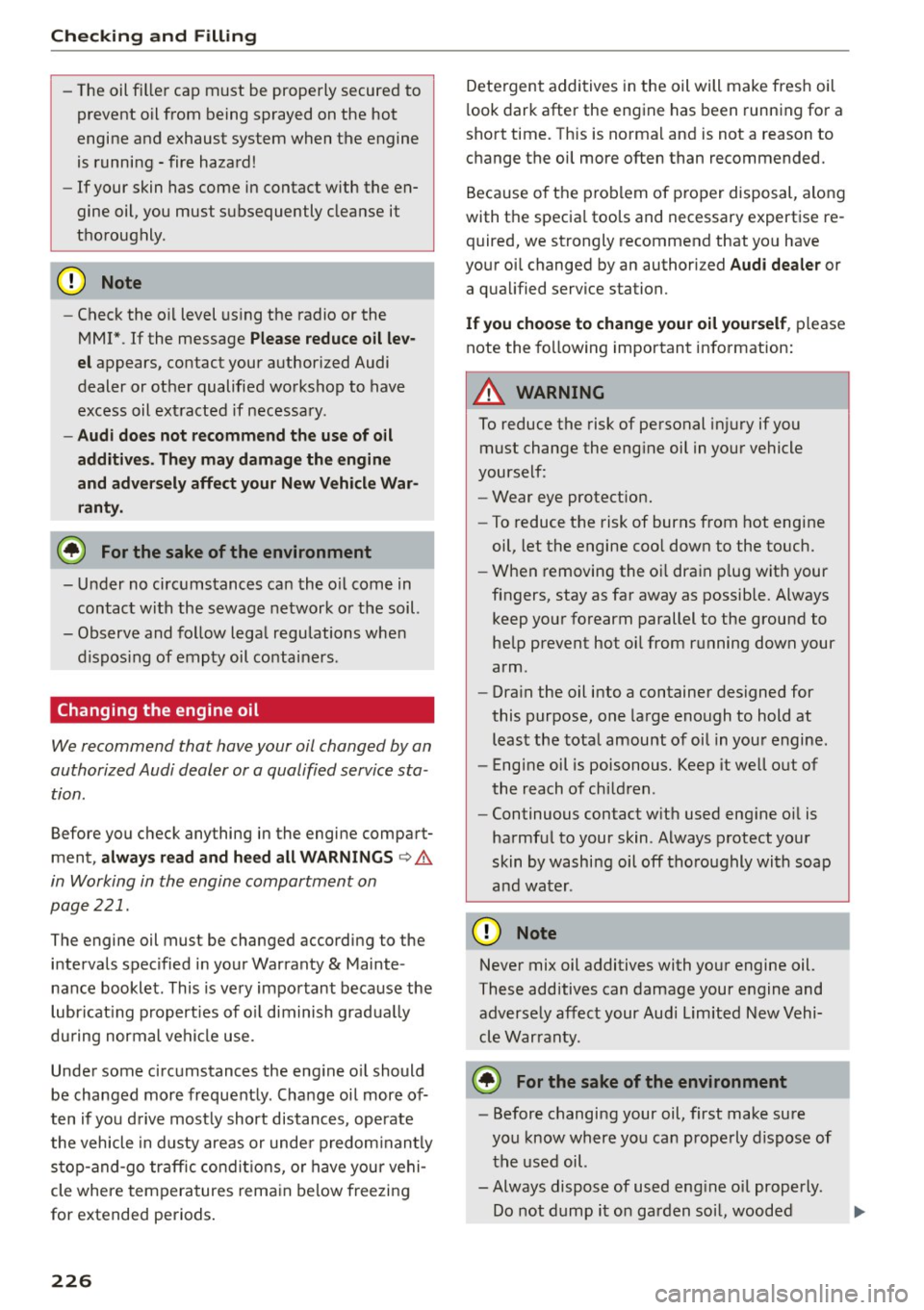
Checking and F ill in g
- The oi l fi ller cap mus t be pr operly secured to
p re vent oil from being sprayed on the hot
engine and exhaust system when the engine
is running - fire hazard!
- If your skin has come in contact with the en
gine oil, you must subsequently clea nse it
tho roughly .
CD Note
-Check the o il level using the radio or the
MMI*. If the message
Please reduce oil lev
el
appears, contact your authorized Audi
dealer or other qualified wo rkshop to have
excess oil ext racted if necessa ry .
- Audi does not recommend the use of oil
additive s. They may damage the engine
and adversely affect your New Vehicle War
ranty .
@ For the sake of the environment
- Under no circ umstances ca n the o il come in
contact w ith the sewage network o r the soil.
- Observe and fo llow lega l regu lations whe n
dispos ing of empty oil co ntaine rs .
Changing the engine oil
We recommend that have your oil changed by an
authorized Audi dealer or a qualified service sta
tion .
Before you check any thing in the engine compart
ment,
always read and heed all WARNINGS c> .&.
in Working in the engine compartment on
page 221 .
The engine oil must be changed according to the i n terva ls specified in your Warranty
& Mainte
nance booklet . This is ve ry impo rtant because the
lubricat ing propert ies of o il diminish gradua lly
du ring normal ve hicl e use.
Unde r some circumstances the eng ine o il should
be changed more frequent ly. Change oil more of
ten if yo u drive most ly short distances, operate
t he vehicle in d usty areas or unde r predom inan tly
s top-and-go traff ic co ndit io ns, o r have you r vehi
cle where tem peratures rema in be low freezing
for extended periods .
226
Detergent additives in the oil will make fresh oil
l ook dark after the engine has been running fo r a
short time. Th is is norma l and is not a reason to
c h ange the oi l more often than recommended.
Beca use o f the p rob lem of p roper disposal, along
with t he specia l too ls and necessary expertise re
quired, we strongly recommend that yo u have
your oi l changed by an authori zed
Audi dealer or
a q ua lified service station.
If you choose to change your oil yourself , please
note the fo llow ing important info rmat ion:
_& WARNING
To reduce the risk of personal inj ur y if you
must change the eng ine oil in your vehicle
yourself:
- Wear eye protect ion.
- To reduce t he risk of burns from hot eng ine
oil, let the engine coo l d own to the to uch.
-
- W hen removing the o il dra in p lug with your
fingers, stay as far away as possible. Always
keep you r forearm parallel t o the ground to
he lp prevent hot o il from running down your
arm .
- Dra in the oil i nto a container designed for
this purpose , one large enough to hold at
l e ast the tota l amount o f oil in you r engine.
- Engine oil is poisonous. Keep it we ll out of
the reach of ch ildren .
- Continuous contact w it h used eng ine oi l is
ha rmf ul to your skin . Always protect your
skin by washi ng oil off tho roughly wi th soap
a nd wate r.
CD Note
N eve r mix oil additives with you r engine oil.
These add itives can damage your engine and
adverse ly affec t your Aud i Lim ited New Vehi
cle Warranty.
@ For the sake of the environment
-Before changi ng your oil , first make sure
you know wh ere you ca n prope rly dispose of
t h e us ed oil.
- Always disp ose of used eng ine oil properly.
Do not dump it o n garden soi l, wooded
Page 229 of 302
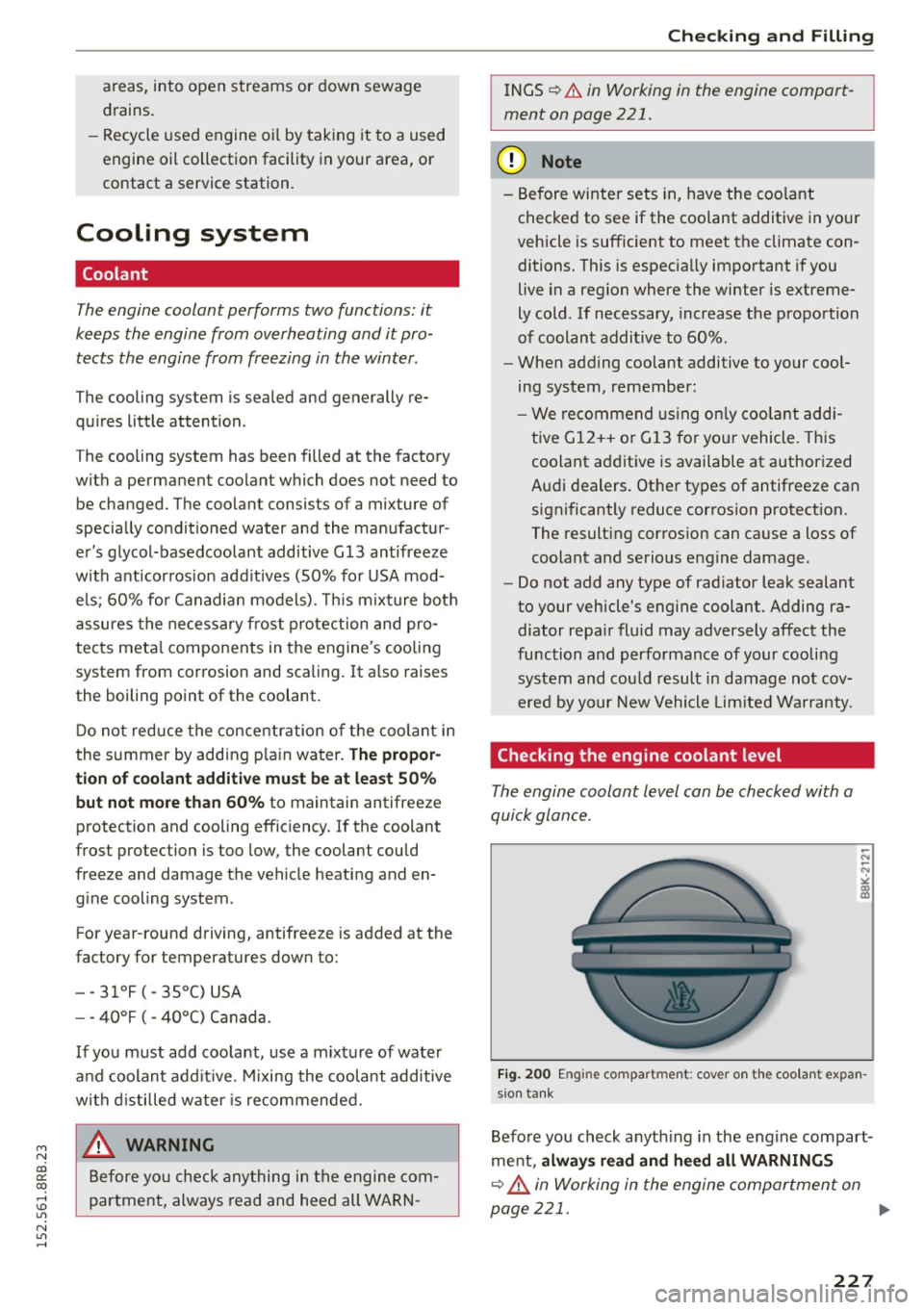
M N
co
a:
co
,...., \!) 1.1'1
N 1.1'1 ,....,
areas, into open streams or down sewage
drains.
- Recycle used engine oil by taking it to a used
engine oil collection facility in your area, or
contact a service station.
Cooling system
Coolant
T he engine coolant performs two functions: it
keeps the engine from overheating and it pro
tects the engine from freezing in the winter .
The cooling system is sealed and generally re
qu ires little attention .
T he cooling system has been filled at the factory
with a permanent coolant which doe s not need to
be changed . T he cool ant consists of a mixture of
specia lly condit io ned water and the ma nufactur
e r's g lycol-basedcoo lant additive G 13 antifreeze
w ith a nticorros ion add itives (50% for USA mod
e ls; 60% for Canadian models) . Thi s m ixt ure bot h
a ssures the ne cessary frost protection and pro
tec ts meta l components in the engine 's cooling
system from corrosion and sca ling. It a lso raises
the boiling point of the coolant.
D o not red uce the conce ntra tion o f th e coo lant i n
the summer by add ing p la in wa ter.
The propor
tion of coolant additive must be at least 50% but not more than 60 %
to maintain antifreeze
protection and cooling efficiency . If the coolant
frost protection is too low, the coolan t could
freeze and damage t he vehicle heat ing and en
g ine cooling system .
For yea r-round driving, antifree ze is added at the
factory for tempe ratu res down to:
- -31°F ( -35°C) USA
- - 4 0°F ( - 40°C) C anada .
I f yo u mu st add coo lant, use a m ixt ure of wate r
a nd coolant add it ive. Mixing the coolant additive
with d istilled water is recommende d.
_& WARNING
Be fore yo u check any thing i n the engine com
par tment, always read and hee d all WAR N-
Checking and Fillin g
IN GS ¢ .& in Working in the engine compart
ment on page 221.
@ Note
- Be fore winte r sets in , have the coo lant
checke d to see if the coolant additive in you r
vehicle is sufficient to meet the climate con diti ons. This is espec ia lly important if you
live in a region where the winter is extreme
ly cold . If necessary, increase the p ropo rtion
o f coolan t addi tive to 60%.
- Whe n adding coolant additive to your cool
ing system, remember :
- We recommend using o nly coo lan t add i
tive G12++ o r G13 fo r yo ur vehicle . This
coolant ad dit ive is available at author ized
A ud i dealers . Othe r types of antifreeze ca n
significantly reduce cor rosion protect ion .
The resulting cor rosion can ca use a loss of
coolant a nd serious e ngine damage .
- Do not add any type of rad iator leak sealant
to your vehicle's engine coolant. Adding ra diat or repa ir flu id may adverse ly affect the
function and perfo rmance of your cooling
system and cou ld result i n damage not cov
ere d by your New Vehicle Lim ited W arra nty .
Checking the engine coolant level
Th e engine coolant level can be checked with a
quick glance.
Fi g. 200 Engin e compar tmen t: cov er on th e coo lant ex pan
s io n ta nk
Befo re you ch eck a nyth ing in the eng in e compart
me nt,
always read and heed all WARNINGS
¢ ,& in Working in the engine compartmen t on
page 221.
~
227
Page 230 of 302

Checking and Filling
"'Park your vehicle on a level surface.
"'Turn off the ignition.
"'Read the engine coolant level from the coolant
expansion tank
c:> fig . 200, <=> page 223,
fig. 197. With a cold engine, the coolant level
should be between the "MIN" and "MAX" mark
ings . When the engine is warm, the level may
be slightly above the "MAX" marking .
The location of the coolant expansion tank can be
seen in the engine compartment illustration
<=> page 223 .
To obtain an accurate reading, the engine must
be switched off.
The expansion tank in your vehicle is equipped
with an electric coolant level sensor.
When the coolant level is too low, the warning
light in the Auto-Check System
c::> page 29 will
blink until you add coolant and the level has been
restored to normal. Even though there is an elec
tric coolant level sensor, we still recommend you
check the coolant level from time to time .
Coolant loss
Coolant loss may indicate a leak in the cooling
system. In the event of coolant loss, the cooling
system should be inspected immediately by your
authorized Audi dealer. It is not enough merely
to add coolant .
In a
sealed system, losses can occur only if the
boiling point of the coolant is exceeded as a re
sult of overheating.
0 Note
Do not add any type of radiator leak sealant
to your vehicle's engine coolant . Adding radia
tor repair fluid may adversely affect the func
tion and performance of your cooling system
and could result in damage not covered by
your New Vehicle Limited Warranty .
Adding coolant
Be very careful when adding engine coolant.
Before you check anything in the engine compart
ment,
always read and heed all WARNINGS
228
c::> A in Working in the engine compartment on
page
221.
Requirement: There must be a residual amount
of coolant in the expansion tank
<=>(i) .
"'Turn off the engine.
"' Let the engine cool down.
"' Place a thick rag over the coolant expansion
tank
c::> page 22 7, fig. 200 and carefully turn
the cap counter-clockwise
c::> .&, .
"'Add coolant mixed in the correct ratio
c::> page 22 7, Coolant up to the MAX marking.
"'Make sure that the fluid level remains stable.
Add more coolant if necessary .
"'Twist the cap on again
tightly.
Replacement engine coolant must conform to ex
act specifications
c::> page 22 7, Coolant.
We recommend using only coolant additive Gl2+
+, Gl3
or in an emergency Gl2+. Do not use a
different additive. In an emergency use plain wa
ter until you can get the correct additive and can
restore the correct ratio. This should be done as
soon as possible.
If you have lost a considerable amount of cool
ant, then you should add cold antifree ze and cold
water only when the engine is cold.
Always use
new engine coolant when refilling.
Do not fill coolant above the "MAX" mark. Excess
coolant will be forced out through the pressure
relief valve in the cap when the engine becomes
hot.
A WARNING
- The cooling system is under pressure and
can get very hot. Reduce the risk of scalding
from hot coolant by following these steps.
- Turn off the engine and allow it to cool
down.
- Protect your face, hands and arms from
escaping fluid and steam by covering the
cap with a large, thick rag.
- Turn the cap slowly and very carefully in a
counter-clockwise direction while applying
light, downward pressure on the top of
the cap.
ll-